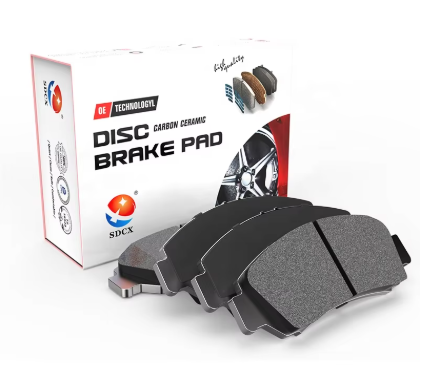Ծախսի ան전ության մեջ բրեյք պադերի դերը
Վերջադարձ: Կենտրոնական մեխանիզմը դադարության ժամանակ
Շարժակազմերի անվտանգությունն ապահովելու համար շատ կարևոր են ավտոդանդաղեցման ափսեները, քանի որ դրանք ստեղծում են շփման ուժ ավտոդանդաղեցման դիսկերի նկատմամբ, երբ վարորդները ցանկանում են դանդաղել կամ ամբողջովին կանգ առնել: Առաջացած շփման քանակը կարևոր է ավտոդանդաղիչների արդյունավետության և ավտոմեքենայի կանգնելու ճանապարհի հեռավորության վրա: Ավտոդանդաղեցման ափսեները պատրաստվում են տարբեր նյութերից, ներառյալ կերամիկական տարբերակներ, կիսամետաղային խառնուրդներ և օրգանական միացություններ: Այդ նյութերը ազդում են ափսեի և դիսկի միջև առկա մաշվածքի քանակի վրա, հատկապես կախված ճանապարհային պայմաններից և եղանակային գործոններից: Փորձարկումներ ցույց են տվել, որ շփման ճիշտ հավասարակշռությունը ավելացնում է ավտոմեքենայի ընդհանուր ղեկավարելիությունը, երբեմն կրճատելով կանգի ճանապարհը արտակարգ իրավիճակներում մոտ 20-30 տոկոսով: Նյութերի տեսակների և դիսկերի հետ փոխազդեցության իմացությունը շատ կարևոր է ավտոդանդաղիչների արդյունավետությունը առավելագույնի հասցնելու և ճանապարհային անվտանգությունն ապահովելու համար:
חוםարությունը և կարողությունը ճնշում են կանգնել
Շարժական ճանապարհներում ավտոբրիկները պետք է դիմանան բարձր ջերմաստիճաններին, հատկապես այն դեպքերում, երբ ամեն անգամ բրիկի վրա ճնշում է կիրառվում, առաջանում է ջերմաստիճանի կտրուկ թռիչք: Նյութեր, որոնք դիմանում են բարձր ջերմաստիճաններին, ինչպես օրինակ կերամիկական և կիսամետաղական տարբերակները, որոշիչ նշանակություն են ունենում այդ մասերի կյանքի տևողության և դրանց աշխատանքի արդյունավետության վրա: Ջերմային կայունությունը կարևոր է, քանի որ հակառակ դեպքում առաջանում է այնպես կոչված «բրիկի թուլացում», երբ կանգնելու ուժը անհետանում է մի քանի կտրուկ կանգերից հետո: Բարձր որակական բրիկները իրենց ամբողջական գործառույթները պահպանում են նույնիսկ այն դեպքում, երբ ջերմաստիճանը գերազանցում է 600 Ֆարենհեյթի աստիճանը, առանց անվտանգության և ընդհանուր արդյունավետության սահմաններին վնաս հասցնելու: Սա գործնականում նշանակում է, որ վարորդները կարող են համարել իրենց բրիկները ամենօրյա երթուղիներում կամ լեռնային ճանապարհներում հավասարաչափ արդյունավետ աշխատող մեխանիզմ:
Սահմանափակություն տունավորման դիսկերի հետ օպտիմալ աշխատանքի համար
Ճիշտ ավտոբրին փողերը ընտրելը ձեր մեքենայի համար կարևոր է ապահովելու համար ճիշտ արգելակման հնարավորությունը և ճանապարհային անվտանգությունը: Երբ դրանք չեն համապատասխանում, վարորդները հաճախ նկատում են փողերի անհավասար մաշվածքը, անհարմար ձայները արգելակելիս և ավելի երկար արգելակման ճանապարհը: Ինչպե՞ս վարվել: Նախքան նոր փողերի տեղադրումը, ստուգեք համատեղելիությունը: Ճիշտ համապատասխանությունը ապահովում է ամեն ինչ ճիշտ աշխատի առանց ավելորդ շփման և ջերմության կուտակման, որը կարող է վատացնել արդյունքները: Համատեղելիության պարբերական ստուգումները նաև գումար են խնայում երկար տեսակետից, քանի որ անհամապատասխան մասերը ավելի արագ մաշվում են, ինչը նշանակում է ավելի հաճախադեպ փոխարինում և հնարավոր վտանգավոր իրավիճակներ վարելիս:
Ինչպե՞ս Դուրս Դեղացող Դիսկեր Համոզվեք 牢ունկ Կորուստի Գործառնայինությունը
Պատասխանատու Բրեյկի Գործառնայինություն Երևանական Սիտուածներում
Շարժական արգելակների ճիշտ աշխատանքի ապահովման գործում արգելակման աստիճանը կարևոր դեր է խաղում արտակարգ դադարների ընթացքում: Այս մասերը պետք է դիմանան լարված ճնշման իրավիճակներին՝ առանց ձախողվելու, ինչը վարորդներին ապահովում է բախումներից խորանալու համար անհրաժեշտ արգելակման հզորությամբ: Երբ ճիշտ ստուգվում է, մենք պարզում ենք, որ սպասարկվող արգելակման աստիճանները իրականում կրճատում են արգելակման ճանապարհը մաշվածների համեմատ: Մտածեք այն մասին, թե ինչ է տեղի ունենում անակնկալ վտանգավոր արգելակման դեպքում՝ այդ լրացուցիչ միլիվայրկյանները կարող են անվտանգության և աղետի միջև տարբերություն լինել: Այնպիսի բաներ, ինչպիսիք են աստիճանի հաստությունը և որակյալ նյութերը, որոշում են, թե արդյոք ավտոմեքենան կարող է ամբողջովին կանգ առնել բավարար արագությամբ: Այդ իսկ պատճառով այս մասերը պետք է ստուգվեն կանոնավոր կերպով և դա պետք է լինի ցանկացած վարորդի սպասարկման գրաֆիկի մի մասը:
Պահանջագրություն անհարմար ավարտի պայմաններում
Երբ խոսքը վերաբերում է արգելակման աստիճաններին, հուսալիությունը ամենակարևոր բանն է, հատկապես այն վատ եղանակային օրերին, որոնց դեմ բոլորս էլ անտանելի ենք՝ անձրև, ձյուն և նույնիսկ այրող ջերմություն: Որոշ արգելակման աստիճանների դիզայներ ավելի լավ են աշխատում այդ պայմաններում, քանի որ պատրաստված են այնպիսի նյութերից, որոնք ապահովում են ճանապարհի մակերեսի հետ համեմատաբար լավ միացում, նույնիսկ ամեն ինչ բարդանում է: Վերցրեք, օրինակ, խորանալ ճանապարհը: Ուսումնասիրությունները ցույց են տվել, որ որակյալ արգելակման աստիճանները կարող են մեծապես նվազեցնել սայթաքելու խնդիրը, ինչը ցանկանում է յուրաքանչյուր վարորդ, երբ սառույցով պատված տեղեր են հանկարծ հայտնվում: Եզրափակելով՝ ճիշտ արգելակման աստիճանները հնարավորություն են տալիս հանգիստ մտածել, որ ձեր ավտոմեքենան կանգ կառնի այնպես, ինչպես պետք է, անկախ նրանից, թե ինչ է նետում մեզ դեպի մենք բնությունը:
Դժվար ֆունկցիոնալության միջոցով անհանգստության պարանել
Եթե ցանկանում ենք, որ մեր ավտոմեքենաները ճանապարհներում մնան անվտանգ, ապա ավելի լավ է ավելի հաճախ ստուգել արգելակները: Լավ արգելակային աստիճանները վարորդներին ապահովում են անհրաժեշտ կանգառի ուժով ամբողջ ճանապարհի ընթացքում: Եթե մարդիկ հետևում են ստուգումների կանոնավոր կատարմանը և փոխում են մաշված աստիճանները նրանց ամբողջական անջատմանը մասնակցելուց առաջ, ապա կարող են խորապես կրճատվել արգելակների անակնկալ անջատման դեպքերը, որոնք կարող են հանգեցնել վթարների: Այս կապը մեխանիկները ամենօրյա հիմքով տեսնում են իրենց աշխատանքներում՝ վատ արգելակային աստիճանների և ավելի բարձր վթարավիճակների միջև: Այդ իսկ պատճառով աստիճանների ստուգումը պարտադիր չէ միայն ավտոմեքենայի ձեռնարկների ցուցումներից բխող գործողություն լինի, այլ նաև ամենախելամիտ բաներից մեկը, որ կարող է ցանկացած վարորդ անել իր և մյուսների անվտանգությունն ապահովելու համար ճանապարհներում և քաղաքային փողոցներում:
Նշանները՝ երբ ձեր բրեյք ցուցչերին պետք է փոխարինել
Կոչումներ կամ կոտրումներ
Երբ արգելակները սկսում են անոմալ ձայներ հնչեցնել, ինչպես օրինակ՝ սուր ճռուքներ կամ շփում, սովորաբար դա նշան է, որ ինչ-որ բան պետք է ուշադրություն դարձնել: Շատ հաճախ այդ ձայները նշանակում են, որ արգելակային աստիճանները մեծապես մաշվել են: Այն, ինչ տեղի է ունենում, այն է, որ մետաղյա մասերը սկսում են անմիջականորեն հպվել միմյանց, քանի որ դրանց միջև ոչինչ չի մնացել: Սա ոչ միայն անճշտություն է, այլ նաև վտանգ է ստեղծում վարորդի համար: Եթե այն անտեսվի բավականաչափ երկար ժամանակով, ապա բաները կարող են շատ վատանալ: Ռոտորները կարող են դեֆորմացվել, կամ էլ արգելակները կարող են ամբողջովին անհետանալ ամենակարևոր պահին: Երկու դեպքում էլ այդ խնդիրները հետո լուծելն ավելի շատ գումար է նշանակում, քան վաղ հնարավորության դեպքում ստուգում կատարելը: Մեխանիկները միշտ խորապան են հաճախորդներին ավտոմեքենան բերել ճիշտ ստուգման ենթարկելու արգելակային համակարգի վերաբերյալ, երբ հայտնվում են անսովոր ձայներ: Այս դեպքում ավելի լավ է անվտանգ լինել, քան ցավոք հետո հիշել:
Միջոցավոր տորմոզային պատշաճ
Երբ արգելակները սկսում են ավելի դանդաղ արձագանքել և ավելի երկար է տևում, քան սովորաբար, հաճախ այդ պահն է մտածելու արգելակային ափսեները փոխարինելու մասին: Ամենահաճախը սա տեղի է ունենում, քանի որ ափսեները ժամանակի ընթացքում մաշվել են կամ ստացել են փայլուն մակերես մշտական օգտագործումից, ինչի շնորհիվ էլ դրանք այլևս չեն կարող այնքան լավ բռնել: Ուսումնասիրությունները ցույց են տվել, որ նույնիսկ արգելակման փոքր ուշացումները կարող են մեքենայի կանգնելու ճանապարհի վրա մեծ ազդեցություն թողնել, ինչը հատկապես կարևոր է անակնկալ վթարային իրավիճակներում: Բացի հարմարությունից, արգելակների արձագանքումը պահպանելը նաև անվտանգության հարց է: Շահագործողները, ովքեր անտեսում են արգելակների սպասարկումը, ճանապարհին իրենց իսկ կյանքին վտանգ են ստեղծում, հատկապես այն իրավիճակներում, երբ ամեն մի վայրկյան կարևոր է վտանգը նկատելու և ավտոմեքենան անվտանգ կերպով կանգնեցնելու միջև:
Դիտելի սանդերի վարդագրի ցույցատրույթները և հաստության կորուստը
Շատ կարևոր է հսկել արգելակի ասպանդակների հաստությունը, որպեսզի մեր ավտոմեքենաները անհրաժեշտության դեպքում ճիշտ կերպով կանգ ապահովենք: Այսօրվա համակարգերում արգելակի ասպանդակները հաճախ ունեն մաշվածության ցուցիչներ, որոնք կամ ձայնային զգուշացում են տալիս, կամ տեսանելի նշան են ցույց տալիս, երբ ասպանդակները շատ մաշված են: Ամբողջական տեսանելի ստուգումները օգնում են հայտնաբերել անհավասար մաշվածության օրինաչափություններ, որը կարող է վկայել անիվների դիրքի խնդիրների կամ ավտոմեքենայի սպասարկման կարիքի մասին: Ընդհանրապես մեխանիկները խորապորձում են ասպանդակները փոխարինել, երբ դրանց հաստությունը դառնում է 3 մմ-ից պակաս: Սա ապահովում է արգելակների ճիշտ աշխատանքը և անվտանգությունը ճանապարհներում՝ ցանկացած վարումների պայմաններում:
Պահպանել Դուրս Դեղացող Դիսկեր համար Երկարաժամանական Անտառություն
Կանխիկ Ստորագրություններ և Համարյալ Փոխարինումներ
Հաճախակի ստուգելով արգելակները՝ կարելի է հայտնաբերել այն նախազգուշական նշանները, երբ արգելակների կափարիչները սկսում են սպառվել, մինչ լուրջ խնդիրներ առաջանան։ Մարդկանց մեծ մասը չի հասկանում, թե որքան կարեւոր է սա, մինչեւ ինչ-որ բան սխալ չի ընթանում: "Ամեն ինչ լավ է, եթե վարորդը լավ է վարում։ Մեխանիկական մասնագետները խորհուրդ են տալիս հետեւել մեքենայի մետաղադրամների փոխարինման ժամանակացույցին, որը նշված է մեքենայի ձեռնարկների մեծ մասում։ Այս ժամանակացույցները պատահական առաջարկություններ չեն, այլ արտադրողների կողմից լայնածավալ փորձարկումների հիման վրա իրական ժամանակացույցներ: Երբ վարորդները հետեւում են դրանց, նրանց մեքենաները շարունակում են կանգ առնել պատշաճ կերպով առանց անսպասելի անակնկալների արտակարգ իրավիճակներում: Եվ եկեք ընդունենք, որ ոչ ոք չի ցանկանում ճամփան ընկնել, քանի որ վատթարացած արգելակները ձախողվել են ամենավատ հնարավոր պահին:
Վարումի սերունդներ, որոնք երկարություն տալիս են դարդավոր պատրաստությունների կյանքին
Շահագործողները, ովքեր ընդունում են ավելի հարթ սովորություններ, սովորաբար ավելի լավ մղում են ստանում իրենց արգելակման ափսեներից: Երբ մարդիկ արագանում են ավելի արտահայտված, քան ամեն կանգառի վրա հարթ հատակին, ամբողջ համակարգի վրա ավելի քիչ լարված ճնշում է գործում: Նույնը վերաբերում է արգելակման աստիճանական կերպով ավելի քան ամեն րոպե արգելակները բաց թողնելուն: Շահավետ է նաև ճիշտ հեռավորություն պահել այլ մեքենաներից, քանի որ սա ավելի շատ ռեակցիայի ժամանակ է տալիս անակնկալ կանգ առաջացնելուց առաջ: Այս փոքր փոփոխությունների ամբողջ շղթան ճանապարհները ավելի անվտանգ է դարձնում բոլոր կողմերի համար՝ երկարացնելով այդ թանկարժեք արգելակման բաղադրիչների կյանքը: Շատ մեխանիկներ ցանկացածին կասեն, ով պատրաստ է լսել, որ արտահայտված վարումը լավ է ոչ միայն անվտանգության համար՝ այն իրոք փող է խնայում երկար տեսքով՝ նվազեցնելով փոխարինման ծախսերը ճանապարհին:
Բարության նյութերի և պրոֆեսիոնալ տեղադրման կարևորությունը
Շարժական հնարավոր տարբերակների համար նախատեսված արգելակման ամբողջական համակարգերը ամենամեծ տարբերությունն են անում արգելակման հզորության և ճանապարհային անվտանգության հարցում: Մեխանիկները այդ մասին ավելի լավ են գիտեն, քան ուրիշները, քանի որ նրանք տեսնում են, թե ինչ է տեղի ունենում, երբ մարդիկ փորձում են փոխարինել դրանք ինքնուրույն ավելի էժան տարբերակներով: Իրականում, ճիշտ տեղադրումը նույնքան կարևոր է, որքան լավ մասերի ընտրությունը: Երկրի տարբեր վայրերում աշխատող մեխանիկները նշում են, որ ավելի քիչ խնդիրներ են առաջանում այն արգելակների հետ, որոնք սկզբից ճիշտ են տեղադրվել: Շարժական միջոցների սեփականատերերի համար, ովքեր մտահոգված են իրենց գումարի և անվտանգության հարցով, իսկական արգելակման մասերի և մասնագիտական տեղադրման վրա ավելի շատ գումար ծախսելը ավելի շահեկան է երկար ժամանակահատվածում: Ավելի քիչ այցեր վերանորոգման կենտրոններ նշանակում է ավելի քիչ դադարներ և ավելի ցածր վերանորոգման ծախսեր ապագայում:
Հաճախ տրամադրվող հարցեր
Ինչ են նշանները, որ իմ դուրսնամունքներին պետք է փոխարինել լինել?
Ծանոթ նշանները ներառում են գոցող կամ ճակատող ձայներ, դուրսնամունքի պատասխանության նվազում և արտաքին մոտեցման ցուցանիշներ, որոնք ցույց են տալիս հաստության կորումը։
Քանի՞ հաճախ պետք է ստուգեմ կամ փոխարինեմ իմ դուրսնամունքները։
Խորապես ցուցադրված արտադրողի ցուցումների համաձայն պետք է կատարվեն պարբերական ստուգումներ, որոնք սովորաբար նշված են ձեր մեքենայի սպասարկման ձեռնարկում, և անհրաժեշտության դեպքում փոխարինվեն, սովորաբար երբ դրանց հաստությունը ցածր է 3 մմ-ից:
Ո՞ր նյութերն են լավագույնը բրեյկի սանդալների համար տարբեր գնահատումների դեպքում:
Կերամիկական և կիսամետալական նյութերը շատ հաճախ հաositարկվում են իրենց բարձր ջերմային համոզումների և կարողանալության պատճառով՝ ապահովելով օպտիմալ աշխատանք տարբեր պայմաններում:
Հետևաբար, ինչու՞ է կարևոր բրեյկի սանդալների համատարածությունը դիսկերի հետ:
Համատարածությունը ապահովում է հավասարակշռված գործողություն, պարhindում է անհավասար անջատումը և նվազում է բրեյկի արդյունավետության խնդիրները, պահպանելով մեքենայի ամբողջական անվտանգությունը:

